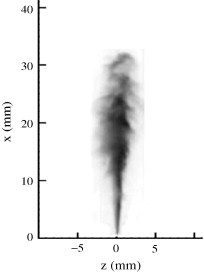The article `A breakup model for transient diesel fuel sprays’ was recently published in FUEL and examines a new approach to modelling how diesel jets breakup into droplets after injection into an internal combustion engine, as well as the shape of the spray produced. The model uses the results of hydrodynamic stability theory to define the breakup length of the coherent jet, and downstream of this point, the spray breakup process is modelled as droplets only. This new composite breakup model is compared with existing breakup models and experimental observations of transient Diesel fuel sprays.
The article also investigates the breakup properties of a new velocity profile for the jet which consists of a plug flow core with a linear shear layer in the gas phase surrounding the liquid core to model the effect of a viscous gas on the breakup process. This velocity profile changes the driving instability mechanism of the jet from a surface tension driven instability for the currently used plug flow jet with no shear layers, to an instability driven by the thickness of the shear layer.
This article was followed up and re-published on the Renewable Energy global innovations website.
The principal author was Matt Turner, with co-authors S.S. Sazhin and C. Crua (Brighton), S.B. Martynov (UCL) and J.J. Healey (Keele).

